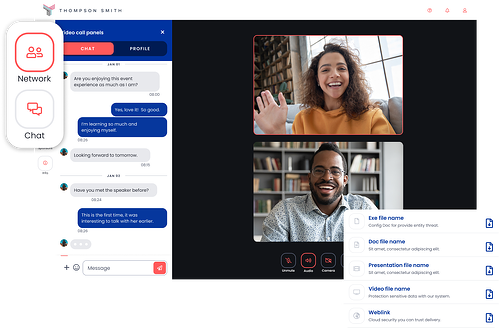5 Immersive Event Experiences with AR and VR Technology
July 6, 2023
In today’s rapidly evolving event landscape, event organizers are constantly seeking innovative ways to captivate attendees and deliver unforgettable experiences. Enter augmented reality (AR) and virtual reality (VR) technologies, which have revolutionized the event industry by offering immersive and interactive encounters like never before. From trade shows to conferences, AR and VR have the power to transport participants into extraordinary realms, enhancing engagement and leaving lasting impressions. In this blog post, we’ll explore five incredible event experiences made possible by AR and VR technology.
Virtual Trade Show Booths:
Traditionally, attending a trade show requires physical presence, which can be challenging for some businesses and individuals due to logistical constraints. However, with VR technology, you can recreate the entire trade show experience virtually. Attendees can explore virtual booths, interact with products and services, and even engage in real-time conversations with exhibitors. The virtual trade show experience offers convenience, accessibility, and a global reach, revolutionizing the way businesses connect and network. It allows exhibitors to showcase their offerings in an interactive and visually stunning environment, while attendees can navigate through the virtual space at their own pace, accessing information and engaging with exhibitors as desired.
Interactive Presentations:
Gone are the days of passive presentations where attendees sit and listen to speakers. AR and VR bring a new dimension to presentations by transforming them into interactive and immersive experiences. Speakers can use AR overlays to enhance visual elements, providing captivating visual aids and dynamic information. Virtual objects can be brought to life, allowing attendees to examine them from different angles and gain a deeper understanding. VR, on the other hand, allows attendees to step into a virtual environment related to the topic, making complex concepts more accessible and engaging. These technologies not only boost attendee engagement but also foster better knowledge retention by creating memorable experiences that go beyond traditional PowerPoint slides.
Virtual Site Visits:
When planning an event, site visits are crucial for organizers to familiarize themselves with the venue and plan logistics effectively. However, physical site visits can be time-consuming and expensive, especially when dealing with international venues. AR technology enables virtual site visits, allowing event planners to explore venues remotely. They can walk through the space, visualize different setups, and make informed decisions without the need for a physical visit. This not only saves time and money but also streamlines the planning process. Event organizers can assess the suitability of a venue, experiment with different layouts, and identify potential challenges well in advance, ensuring a seamless event execution.
Gamified Experiences:
Gamification has proven to be a powerful engagement tool, and AR and VR take it to the next level. By incorporating game elements into events, attendees can participate in interactive challenges, scavenger hunts, and simulations. AR overlays can transform physical spaces into treasure hunts, where attendees search for virtual objects and clues using their smartphones or AR-enabled devices. VR can create fully immersive gaming environments, where participants engage in team-based competitions or simulations related to the event’s theme. Gamified experiences not only increase attendee participation and excitement but also facilitate networking and collaboration among participants, creating a sense of camaraderie and shared experiences.
Virtual Networking:
Networking is a vital component of any event, but it can be daunting for some attendees. AR and VR provide innovative solutions to bridge this gap. With virtual networking, attendees can create customizable avatars and interact with others in a virtual environment. They can engage in one-on-one or group conversations, exchange contact information, and even attend virtual networking events where they can join topic-specific discussions or industry forums. These technologies make networking more accessible, comfortable, and engaging, facilitating meaningful connections among participants. Attendees can connect with like-minded individuals from around the world, expanding their professional network and gaining valuable insights and opportunities.
Conclusion:
AR and VR technologies have transformed the event landscape, offering endless possibilities to create immersive and engaging experiences. From virtual trade show booths and interactive presentations to virtual site visits, gamified experiences, and virtual networking, these technologies have revolutionized the way we plan, attend, and remember events. As the event industry continues to evolve, embracing AR and VR technology will undoubtedly unlock new dimensions of creativity, interactivity, and attendee satisfaction.
By leveraging virtual trade show booths, businesses can reach a wider audience and showcase their offerings in a visually stunning and interactive manner. Interactive presentations using AR and VR captivate attendees and foster better knowledge retention. Virtual site visits streamline event planning by allowing organizers to explore venues remotely and make informed decisions. Gamified experiences inject excitement and engagement into events, while virtual networking creates comfortable and accessible platforms for attendees to connect and forge meaningful professional relationships.
Incorporating AR and VR technology into event experiences not only enhances attendee engagement but also provides unique opportunities for businesses to differentiate themselves in a crowded marketplace. The immersive and interactive nature of AR and VR leaves a lasting impact on attendees, making events more memorable and fostering positive brand associations.
As you plan your next event, consider the potential of AR and VR technology to elevate the attendee experience and set your event apart. By embracing these immersive technologies, you can create unforgettable event experiences that leave a lasting impression on attendees, drive greater engagement, and achieve your event objectives. Stay ahead of the curve and harness the power of AR and VR to deliver remarkable event experiences that will be talked about long after the event is over.
Whether your event is virtual, hybrid, or in-person, enhance your attendee’s journey with an event ecosystem built for your audience. Ready to walk through Stova's event technology solutions? Schedule some time with us today.




